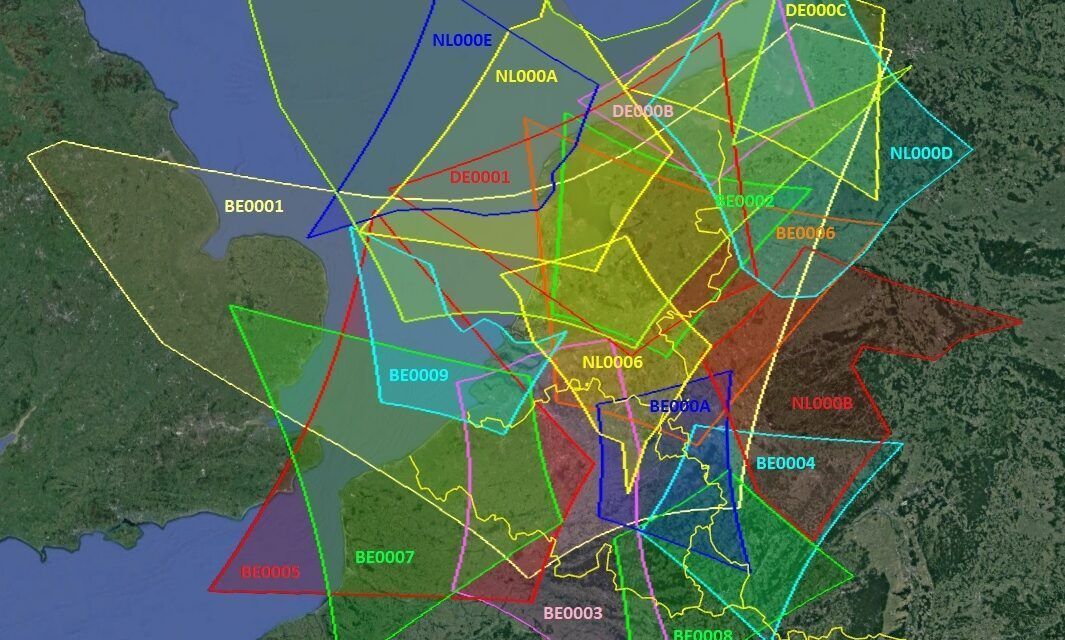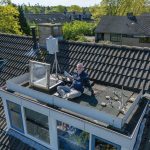Abstract: A summary of the activity of the CAMS BeNeLux network during the year 2021 is presented. The year 2021 brought in general poor weather for astronomical observations. The best months of 2021 were the months August to November. 45985 orbits could be computed during 318 different nights which corresponds to 87% of all 365 nights in 2021. The months September and October had the best scores ever for these months.
Introduction
The first CAMS network started in October 2010 in California (Jenniskens et al., 2011) and CAMS BeNeLux was the first CAMS network outside the USA with 14–15 March 2012 as its starting date. Meanwhile we are almost 10 years later and the CAMS BeNeLux network has exceeded by far all expectations.
In CAMS BeNeLux all the cameras, optics, computers and other required equipment are bought and financed by the participants themselves. Operating cameras for the CAMS network also requires some time on a regular basis to confirm meteors, remove false detections and report the data. The commitment in such project requires a strong motivation which is crucial to maintain these efforts.
Until 2017 CAMS BeNeLux expanded fast in number of cameras while in recent years the total number of cameras did not change much. Some CAMS stations quit, few others joined the network. The total volume of the atmosphere covered by CAMS BeNeLux cameras gradually increased. In recent years the classic Watec H2 Ultimate cameras got less popular and all of the recently added cameras are all RMS which deliver data to both CAMS and Global Meteor Network. Using RMS cameras for the CAMS BeNeLux network has the advantage that these are fully automated and functioning 7 nights on 7.
CAMS BeNeLux 2021 statistics
The year 2021 started with an exceptionally poor week with as few as 31 orbits collected in 7 nights. Hopes for a weather improvement remained unfulfilled with not any single clear night in January, clear spells at best permitted to harvest a modest number of orbits. January 2021 was the poorest month of January in the CAMS BeNeLux history, while a record number of cameras were available. The poor weather persisted into February until the second week when an improvement occurred on 10 February with a series of mostly clear nights followed by variable weather with partial clear nights.
March continued the same weather pattern we got end of February, the first week of March 2021 had some clear nights and longer clear spells. The next ten nights were dominated by cloudy skies. The last period of March had variable circumstances with each night some clear skies, sometimes with almost complete clear nights. April started with one clear night followed by 9 mostly cloudy nights. Luckily the weather improved and remained stable until almost the end of the month. For the fourth year in a row, the CAMS BeNeLux network enjoyed clear sky during much of the Lyrid activity. Unfortunately, many cameras remained switched off during a number of nights, reducing the sky coverage during these nights.
May 2021 was an exceptional cold and rainy month with a lot of cloudy sky and therefore rather unfavorable weather for meteor work. Only 6 nights resulted in 100 or more orbits (against 18 in 2020). The lack of camera capacity affected especially the northern part of the network where the coverage was rather poor during many nights. May 2021 was the poorest month of May since 2016. The first half of June 2021 had a number of clear nights and several with partial clear sky. However, the second half of June came with exceptional poor weather, much too cold and totally overcast with a lot of rain. The worst possible weather pattern made astronomical observing almost impossible.
July 2021 got only few complete clear nights. A combination of unfavorable weather circumstances with less operational cameras available explains why this month was the least successful month of July since 2016. The weather was rather variable during the first week of August but luckily improved for the second week including the rich Perseid nights of 11–12–13–14–15 August. This saved the month since previous years the high scores were mainly obtained without perfect weather during the rich Perseid nights, so we have been lucky. Nobody would expect unforeseen surprises with the best studied and well-known meteor shower like the Perseid, but it did happen. August 13–14 produced a strong unpredicted Perseid outburst visible over Canada and the USA. CAMS BeNeLux recorded during this night as many as 1249 orbits, more than during August 12–13 with the traditional maximum. August 2021 brought less favorable weather than previous two years, but luckily the rich Perseid nights were mostly clear. Altogether it became the 4th best month of August in 10 years of CAMS BeNeLux.
September finally brought favorable weather and CAMS BeNeLux collected 7457 orbits. This is an absolute record for the month September, much better than the record of last year. This month counted as many as 26 nights with more than 100 orbits. The best September night was 7–8 with as many as 543 orbits in a single night, the best score in orbits ever for a September night. Not any single night remained without orbits. The larger number of cameras that were operational also provided better coverage compared to previous years with favorable weather.
Last year we got the worst-case weather scenario for the month October with not a single complete clear night for the entire network. October 2021 was a wet rainy month with a lot of cloud cover during the day, but with several clear nights and wide clear spells at night. For once we got lucky with this autumn month. 9669 orbits were collected (against 3305 in 2020) which is a new record for this month, doing slightly better than October 2018 when 9611 orbits were collected, including 1391 orbits in a single night with the Draconid outburst. Again, no favorable weather during the Orionids apart from some partial clear sky 20–21–22 October, but CAMS BeNeLux could confirm the discovery by the Global Meteor Network of a new shortly active meteor shower (Vida et al., 2021).
Table 1 – Statistics for each month of 2021.Total numbers of nights (N) with orbits, number of orbits, number of camera stations (S), maximum of cameras available (Mx), minimum of cameras available (Mi), average number of cameras (Mm), total number of meteors and percentage of multiple station meteors.
| M | N | Orbits | S | Mx | Mi | Mm | Meteors | % |
| Jan | 22 | 991 | 26 | 92 | 64 | 73.7 | – | – |
| Feb | 25 | 2136 | 26 | 91 | 60 | 78.6 | – | – |
| Mar | 28 | 1998 | 27 | 91 | 59 | 78.9 | – | – |
| Apr | 28 | 3061 | 27 | 91 | 59 | 82.1 | – | – |
| May | 28 | 1500 | 25 | 81 | 50 | 68.2 | – | – |
| Jun | 22 | 1389 | 26 | 81 | 54 | 73.3 | – | – |
| Jul | 28 | 2525 | 27 | 81 | 55 | 67.3 | – | – |
| Aug | 29 | 7496 | 27 | 89 | 65 | 80.2 | – | – |
| Sep | 30 | 7457 | 26 | 93 | 64 | 82.0 | – | – |
| Oct | 29 | 9669 | 26 | 94 | 70 | 82.2 | 51696 | 62% |
| Nov | 24 | 4691 | 26 | 86 | 74 | 81.6 | 25832 | 55% |
| Dec | 25 | 3072 | 25 | 84 | 67 | 76.0 | 19579 | 47% |
| 318 | 45985 |
November 2021 brought fairly good autumn weather for the BeNeLux what resulted in a third-best November month during 10 years of CAMS BeNeLux. This month counted 14 nights with more than 100 orbits. Two nights produced more than 500 orbits in a single night. The best November night in 2021 was 21–22 with as many as 1810 multi-station meteors, good for 578 orbits in this single night. December 2021 brought barely better weather than the horrible poor month of December previous year. With more cameras operational 7 on 7 than previous years, mainly newly installed RMS cameras, the best could be derived from partial clear nights. December 2021 wasn’t as bad as December 2020, but will remain one of the poorest months of December in the CAMS BeNeLux history.
An overview of the monthly statistics for CAMS BeNeLux during 2021 is presented in Table 1. January 2021 was the worst months of 2021 and the exceptional poor weather dominated the first three months, May, June and July as well as December. September 2021 was the best month of the year while October, August and November were good months too.
Good or bad weather determine the success of a camera network, but of course the hardware needs to be available. After a strong build-up of the network in 2017 we had a drop in the number of cameras in 2018 to about 80% of what was available before and the number was kept down throughout 2019 due to technical problems. This is visible in Figure 1, as a drop in the maximum (green line) and the average number (red line) of cameras available each month since 2018. The situation finally improved a lot in the first half of 2020 when less technical problems occurred and a few new cameras were added to the network. Unfortunately, since the summer of 2020 we see again a decline in the number of available cameras. No technical issues, but the variability of the motivation among amateur volunteers is sometimes a problem to maintain long-term projects such as CAMS BeNeLux. This explains why the number of available cameras fluctuates around the level achieved by the network since 2017 although new sites and cameras have been added to the network.
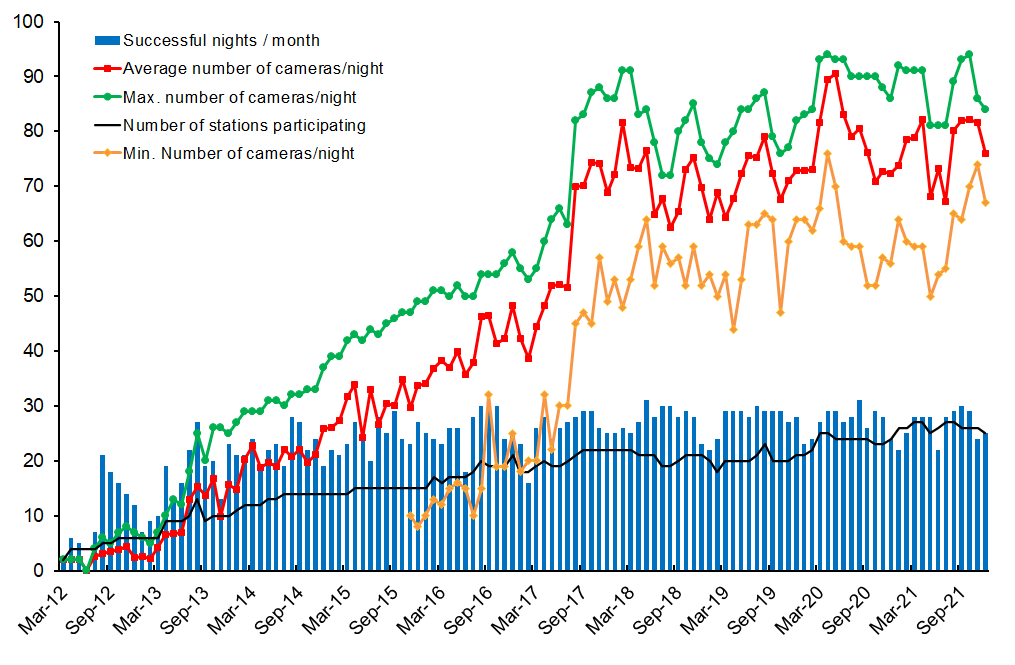
Figure 1 – CAMS BeNeLux performance at a glimpse. The blue bars represent the number of nights with orbits for each month. The black line is the number of operational CAMS stations, the green line the maximum number of operational cameras, the red line the average number of operational cameras and the yellow line the minimum number of operational cameras available.
Some new cameras were added to the CAMS BeNeLux network in 2021 at geometric strategic positions for the existing CAMS stations (see also Figure 2). All new cameras were RMS devices with 6mm optics and 54° × 30° field of view. White dots and placenames in Figure 2 indicate sites with only Watec cameras with 12mm/1.2 optics and a small field of view of 30° × 22°. Yellow dots with white placenames indicate a mixture of Watec and RMS cameras. Yellow placenames indicate sites with only RMS cameras. The orientation of the newly installed camera field can be seen in Figure 3, together with already existing RMS cameras of the network.
- RMS BE0006 alias CAMS 003816 got its first orbits during the night of 12–13 January 2021. This camera is installed at Lesve, Belgium and operated by Pierre de Pontière. This camera is pointed low towards the north and covers a large part of the Netherlands. The rich overlap with many other cameras explains its high score in number of orbits with 5369 orbits recorded in its first year.
- In March we could welcome Ludger Boergerding as new participant with his RMS DE000B, alias CAMS 003801 at Holdorf, Germany. Contributing CAMS data since 15–16 March, this camera has been pointed at the previously poorly covered region of Northern Netherlands and North West Germany. Although coverage on this region needs still enforcement, this camera obtained 2672 orbits.
- With the help of Tammo Jan Dijkema, Reinhard Kühn installed RMS DE000C, alias CAMS 3802 at Flatzby, northern Germany near the border with Denmark. This camera has been pointed south-west to cover the north-western part of Germany, a formerly poorly covered corner of the network. This camera had its first orbits May 27–28.
- RMS camera BE0005, alias CAMS 3817 became operational during the rich meteor night of August 13–14 at OCA, Grapfontaine thanks to the efforts of Jean-Paul Dumoulin, Christian Wanlin and Kees Habraken, This RMS with a 6 mm lens (54° × 30°) has been pointed low in western direction to give coverage on entire western Belgium, Norther France and Zeeland.
- Two new RMS cameras, BE0007 and BE0008 alias CAMS 3818 and 3819, were installed at Cosmodrome in Genk, both RMS cameras with 6 mm lenses with the help of Giuseppe Canonaco. CAMS 3819 is pointed low to the west to cover the western part of Belgium with large overlap with CAMS 3817 at Grapfontaine. CAMS 3818 has been pointed south-east to give coverage on the south-eastern part of Belgium and Luxembourg. Both cameras got their first orbits on August 14–15 for CAMS 3819 and on August 15–16 for CAMS 3818.
- RMS BE0003 formerly installed in Genk and replaced by BE0007, has been moved to AstroLab at Zillebeke, near Ypres in September. Steve Rau took care of the installation of CAMS 3853 (BE0003) pointed in eastern direction to cover central Belgium and Northern France. This RMS had its first orbits September 10–11.
- RMS BE0009 alias CAMS 3851 has been built by Steve Rau. This camera has been pointed north at Astrolab in Zillebeke to provide coverage on the North Sea and Zeeland, a poorly covered part of the network. This camera had its first orbits on September 24–25.
- RMS NL000B alias CAMS 319 has been pointed south-east by Martin Breukers at Hengelo and had its first orbits October 4–5. This region offers new possibilities to expand the network further eastwards.
- Poor weather postponed the installation of the last new camera for 2021, RMS BE000A alias CAMS 3820 installed in Gent, Belgium by Tim Polfliet. This camera has a 8mm lens with a FoV 22 × 41°and had its first orbits December 16–17.
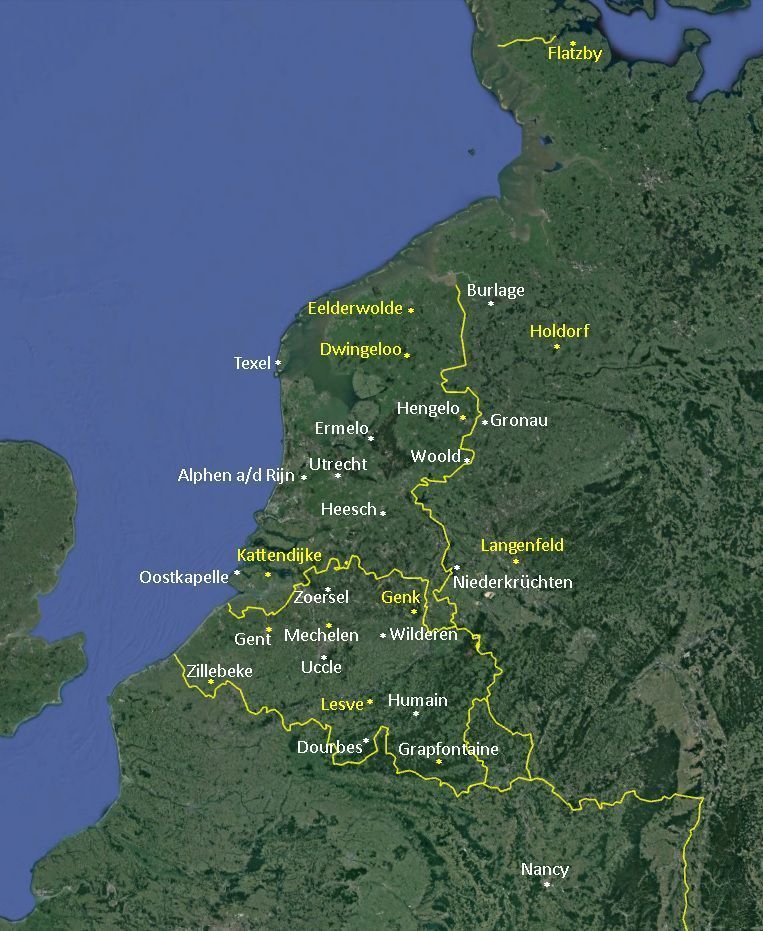
Figure 2 – Locations of all the active CAMS BeNeLux stations and cameras during 2021. Yellow names are GMN RMS stations, yellow dots indicate mixed hardware Watecs and RMS cameras.
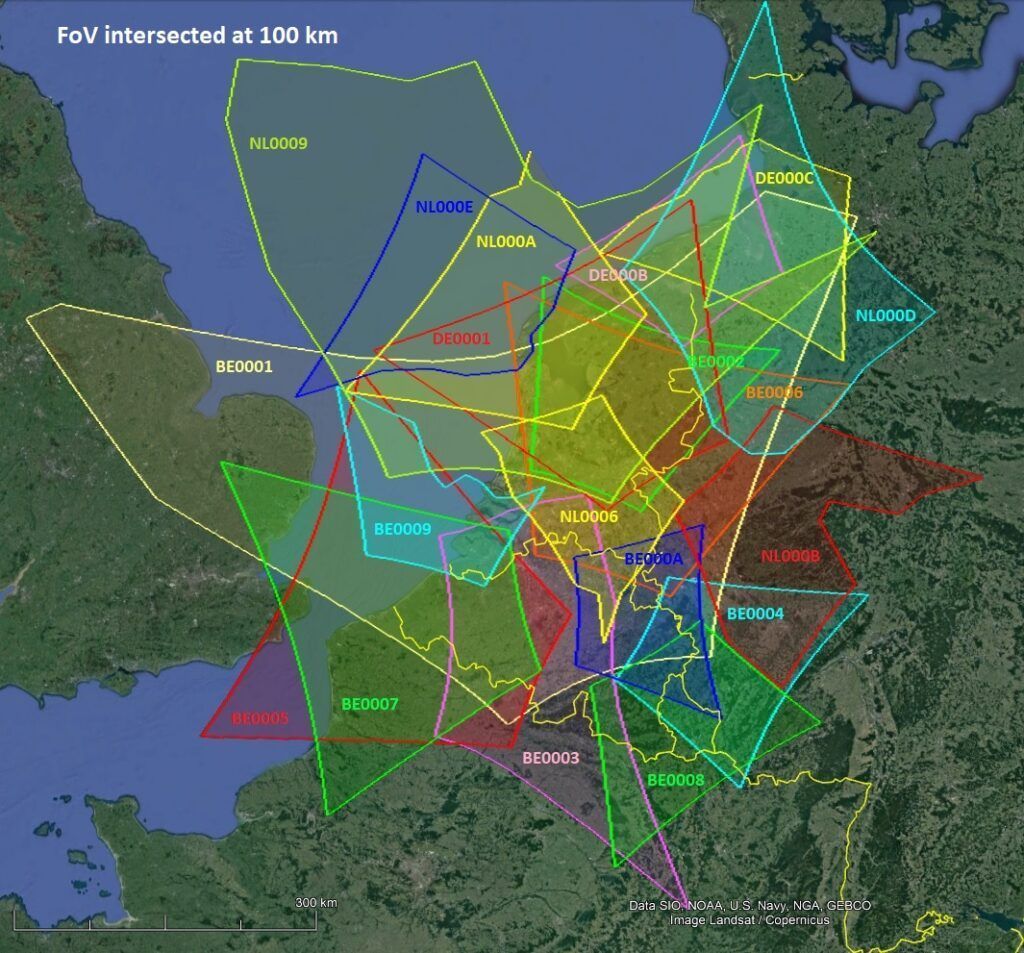
Figure 3 – Fields of View (FoV) of the RMS cameras that contributed to the CAMS BeNeLux network in 2021.
2021 compared to previous years
In total 45985 orbits were collected in 2021 (against 45743 orbits in 2020) which is a remarkable good result for a year with 8 months of unfavorable weather. Slightly more orbits than in 2020 and good for a second-best year after 2018 when as many as 49627 orbits were collected. Figure 4 compares the data from year to year and Table 2 lists the numeric values. From Table 2 we learn that 2021 brought slightly less favorable weather than previous three years with an average number of 26.5 nights with orbits per month. It was the poorest year since 2017. Also, the total number of nights that produced one or more orbits was less than previous three years with 318 nights. This number of nights with orbits is actually huge when considering the often-cloudy atmosphere over the BeNeLux region. More than 300 nights with observational results is something that most people expect for the Provence or other typical astronomical sites. The number of completely clear nights is indeed much less impressive and it would make a substantial difference if our cameras wouldn’t be operated 7 nights on 7.
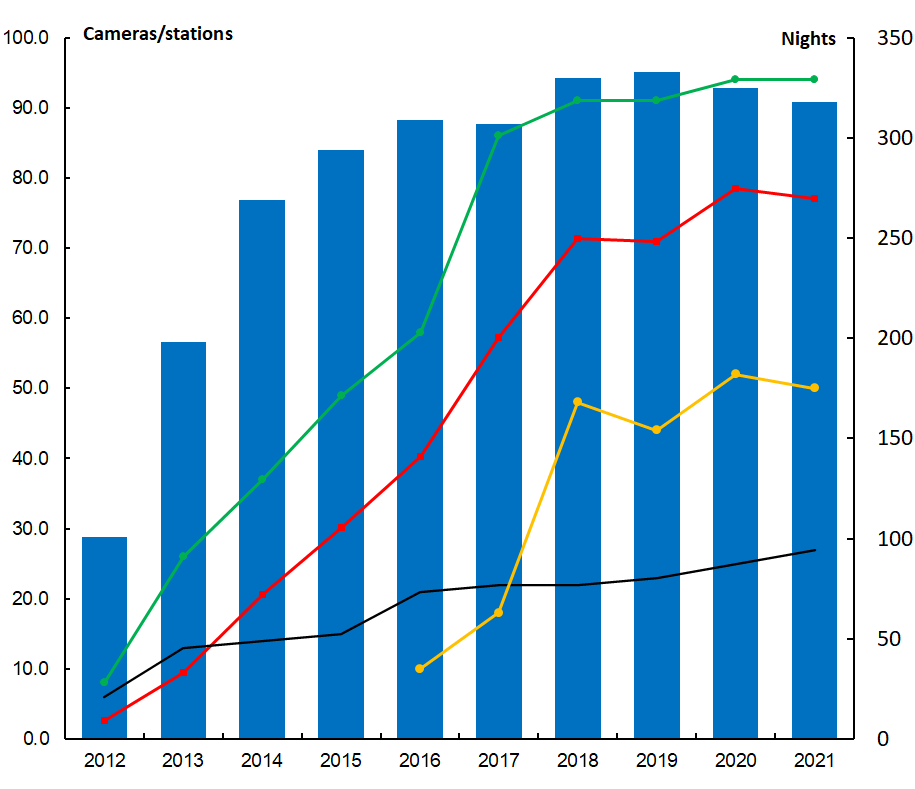
Figure 4 – The performance of the CAMS BeNeLux network from year to year. The blue bars represent the total number of nights during which orbits were obtained. The black line is the number of CAMS stations, the green line the maximum number of cameras available, the red line the average number of cameras available and the yellow line the minimal number of cameras.
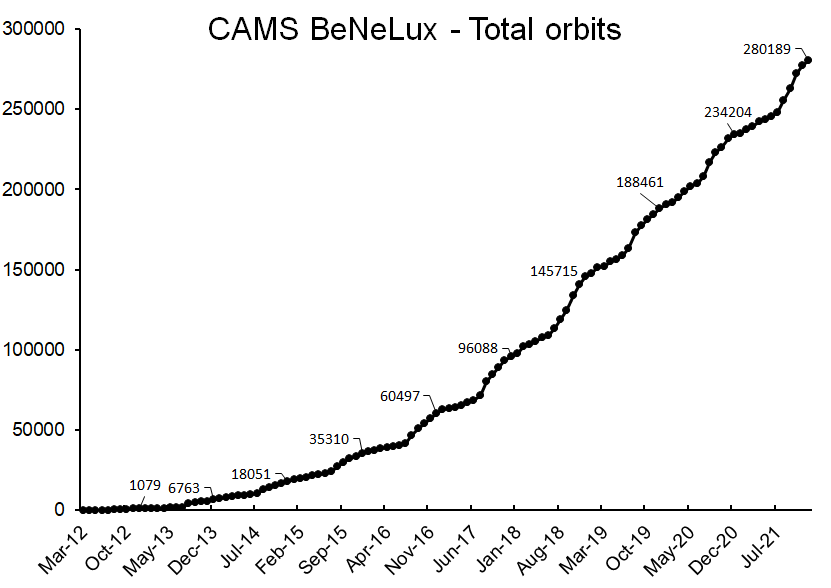
Figure 5 – The evolution of the number of orbits collected by the CAMS BeNeLux network.
Table 2 – Total numbers per year: average number of nights with orbits per month (Dm), orbits, average number of cameras per month (Cm), maximum number of operational cameras, number of operational stations and total number of nights with orbits.
| Year | Dm | Orbits | Cm | Cameras | Stations | Nights |
| 2012 | 10.1 | 1079 | 2.6 | 8 | 6 | 101 |
| 2013 | 16.5 | 5684 | 9.5 | 26 | 13 | 198 |
| 2014 | 22.4 | 11288 | 20.6 | 37 | 14 | 269 |
| 2015 | 24.5 | 17259 | 30.1 | 49 | 15 | 294 |
| 2016 | 25.8 | 25187 | 40.3 | 58 | 21 | 309 |
| 2017 | 25.6 | 35591 | 57.2 | 86 | 22 | 307 |
| 2018 | 27.5 | 49627 | 71.3 | 91 | 22 | 330 |
| 2019 | 27.8 | 42746 | 70.9 | 91 | 23 | 333 |
| 2020 | 27.1 | 45743 | 78.5 | 94 | 25 | 325 |
| 2021 | 26.5 | 45985 | 77.0 | 94 | 27 | 318 |
| 280189 | 2784 |
The use of AutoCAMS for the Watecs and of course the new RMS cameras made the difference! The general bad weather during 2021 has been compensated by permanent coverage by many cameras taking advantage of clear spells during mostly cloudy nights which would be missed unless the cameras function regardless the weather circumstances. This is the basic principle behind meteor camera networks because clear sky proves in general to be pretty unpredictable.
The expansion of the network covering a larger surface than few years ago offered better chances for local clear sky in some regions while other parts of the network remained 100% cloudy. Amateurs who operate their cameras only during predicted clear sky are missing all the unforeseen periods with clear sky. For that reason, all meteor camera networks in the world keep their cameras recording, regardless the weather. The only reason for camera drop-outs are technical problems.
Looking at the accumulated number of orbits over the years in Figure 5, we see how CAMS BeNeLux took off after 2016 when AutoCAMS made it easy to run cameras 7 on 7 and the network got at full strength in 2017. The graph mentions the totals at the end of each year. 2021 ended with an accumulated total of 280189 orbits collected by CAMS BeNeLux. Ten years ago, nobody would ever have expected this to happen. A project like CAMS BeNeLux isn’t a short-term project. The purpose is to keep it going as long as possible, keeping everyone motivated to invest in the maintenance of the network.
Figure 6 shows the number of orbits registered per month; the result often depends on luck with clear sky during major meteor shower activity. The graph shows the large fluctuations from month to month. Some months it may look like clear skies will never return, but even in the worst periods, orbits can be obtained. The CAMS project aims at the times of the year with poorly known meteor activity, away from shower maxima and poorly monitored nights in the past.
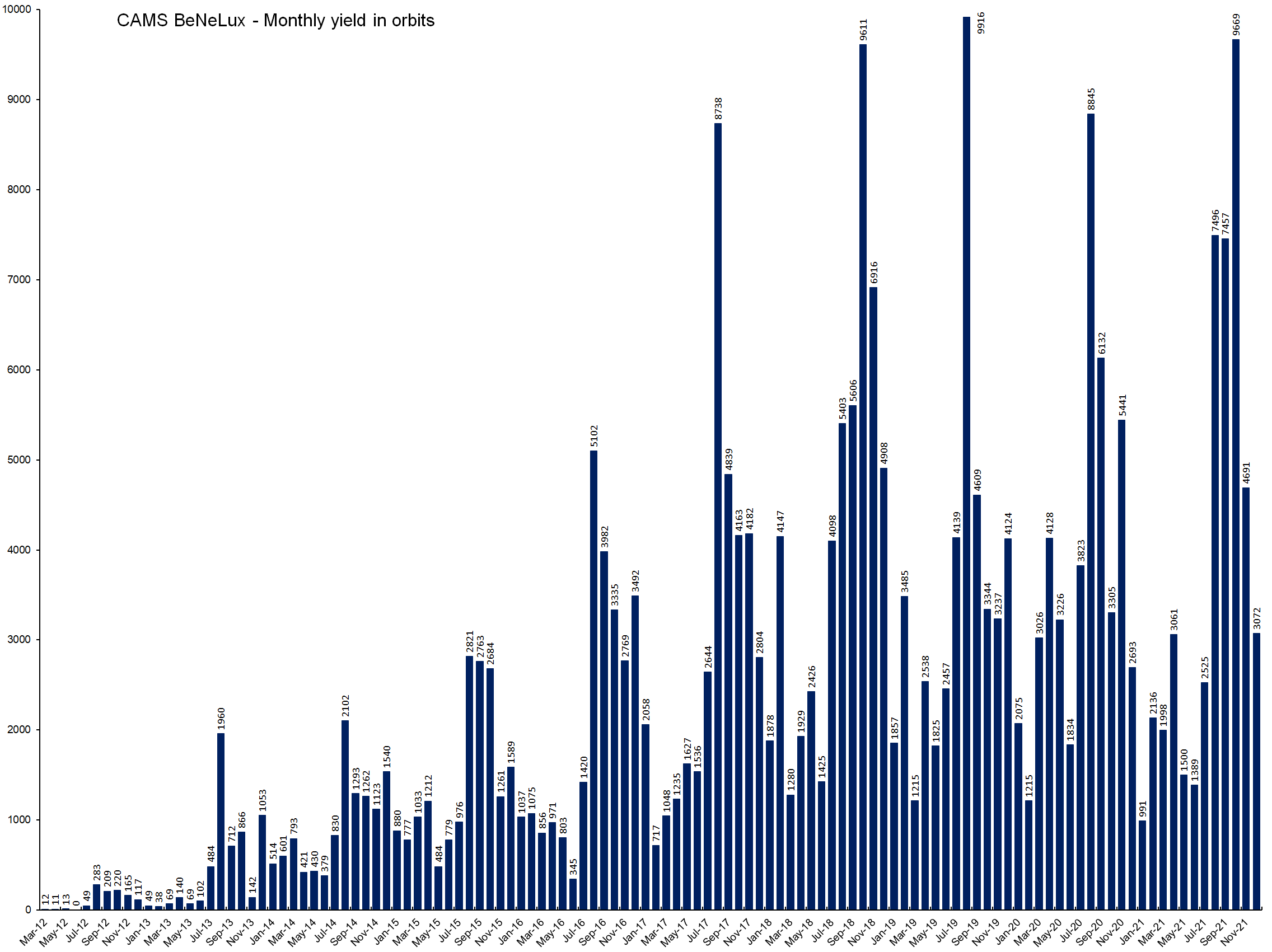
Figure 6 – The total number of orbits collected per month. August 2019 has the record with 9916 orbits in a single month.
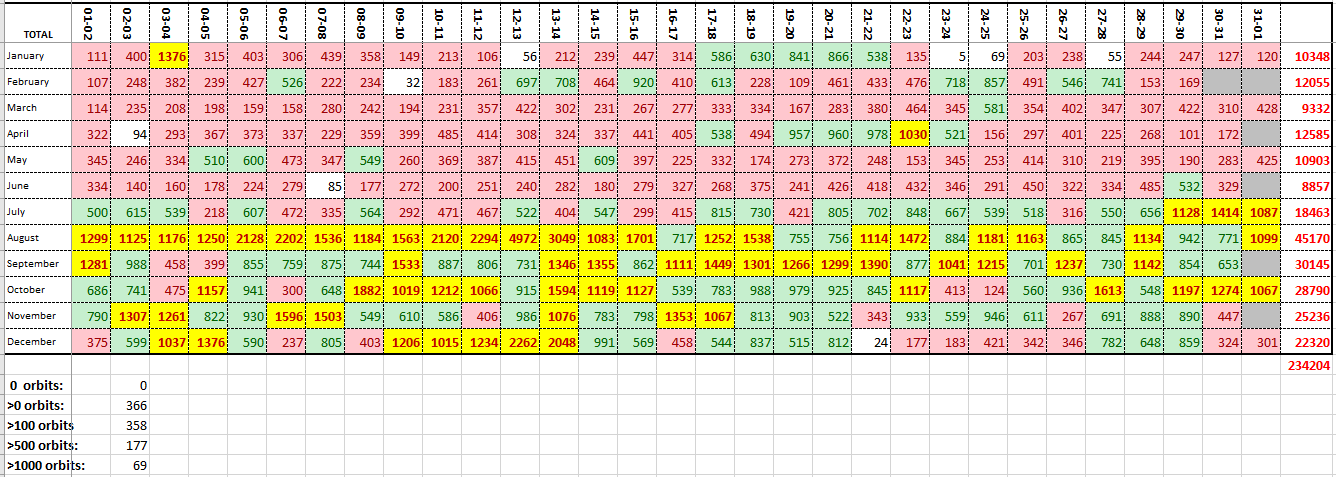
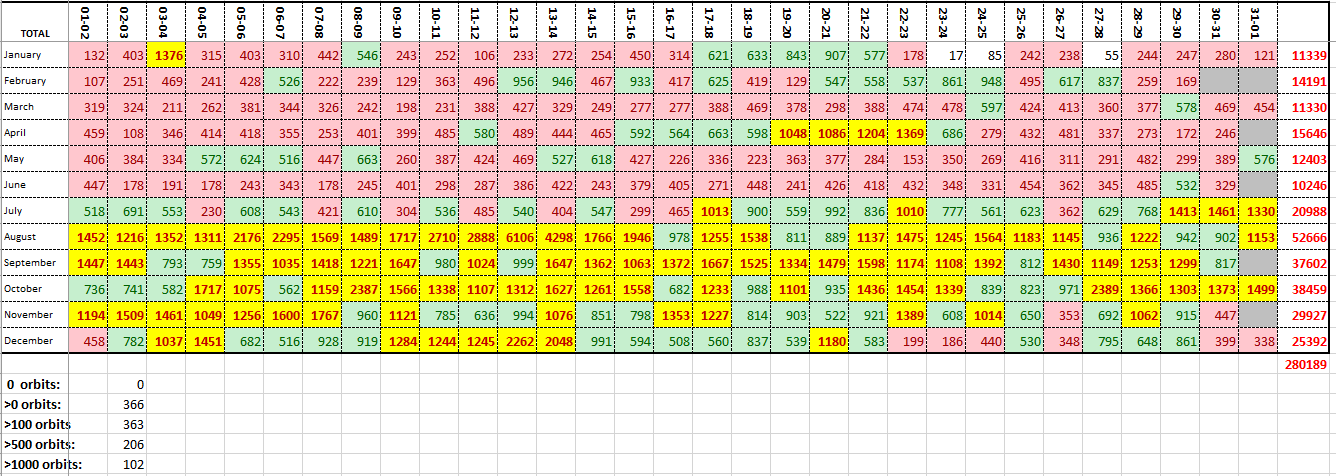
Figure 7 – Day-by-day tally of the cumulated number of orbits per day collected by CAMS-BeNeLux. Top: the overview up to 31 December 2020, bottom: the situation on 31 December 2021.
Ten years ago, at the start of the CAMS project, the purpose of the project was to collect at least a hundred orbits for each calendar date to detect unknown minor showers caused by weak dust trails. This initial target proved to be too modest as meanwhile the BeNeLux Cams network alone almost accomplished this purpose. CAMS proved much more successful than ever expected. In 2021 all the CAMS networks together on average collected more than 1000 orbits per day!
Figure 7 shows the total number of orbits collected per calendar date since 2012 by CAMS BeNeLux alone, until end of 2020 (top) and until end of 2021 (bottom). End 2021 only 3 nights were left with less than 100 orbits with 23–24 January as the most miserable night since 2013 with as few as 17 orbits collected during all these years together. January seems to be the most challenging month for the weather.
End 2021 we had 206 nights with more than 500 orbits, 102 nights had more than 1000 orbits accumulated. The influence of the major meteor showers is reflected in the numbers of orbits: the Quadrantids 3–4 January, Lyrids 22–23 April, the delta Aquariids South end of July, most of the Perseid activity period with as best night 12–13 August with 6106 orbits for the Perseid maximum night. September proves to be a most rewarding meteor month although no major shower is active during this month. The 2387 orbits for 08–09 October were mainly due to the Draconid outburst in 2018. Past 10 years no really favorable circumstances occurred during the rich Orionid activity in October. Sooner or later our network should be lucky with this one! Of course, the Geminids provided large numbers of orbits, but a clear night for the Geminid maximum would change the numbers by a lot. From this overview it is very obvious how rich the meteor activity is in the second half of the year compared to the first half of the year.
Should we use more RMS cameras?
In 2019 the first RMS cameras were used to provide extra coverage to the CAMS BeNeLux network. Looking at Table 3 we see that the best performing cameras are all RMS cameras. The main reason is the larger FoV combined with a very good resolution:
- RMS 36mm 47 × 88°, 3.9 arcmin/pix;
- RMS 6mm 30 × 54°, 2.5 arcmin/pix;
- RMS 8mm 22 × 41°, 1.9 arcmin/pix;
- Watec 12mm 22 × 30°, 2.6 arcmin/pix (PAL);
- Watec 12mm 22 × 30°, 2.8 arcmin/pix (NTSC).
The RMS with 8mm lens comes closest to the classic CAMS configuration with the 1.2/12mm lens. The small FoV proves ideal in light polluted areas. For darker areas the RMS 6mm is the best compromise with significant larger FoV and comparable in resolution to the CAMS standard optics. The RMS 36mm can be used only at very dark skies but the lens distortion is at the limit and therefore not recommended to be used within the CAMS network. The RMS doesn’t need AutoCAMS and functions 7 nights on 7, apart from some occasional technical issues. RMS cameras can be home built for less than 200 euro for a complete system (see https://globalmeteornetwork.org/wiki/index.php?title=Build_A_Camera).
The most important advantage of the RMS is its calibration system. The classic CAMS system uses a single calibration for the entire night while the RMS system recalibrates for each single detection. The resolution of 2 to 4 arcmin/px isn’t the only parameter to look at. During the night the plate center of a CAMS camera, if it is well fixed, wanders around the reference and may deviate 10, 12 or more arcminutes just because of the expansion, contraction of the camera support (arm, wall, mount, …) due to variations in temperature. The classic CAMS approach ignores this completely but the RMS system recalibrates for each individual detection. This is an absolute superior approach compared to the use of a single calibration for a whole night.
Table 3 – Selection of 20 cameras with the highest scores in orbits during the year 2021.
| Camera | Total orbits | Nights active | Nights with orbits |
| 003814 RMS Grapfontaine (B) | 5725 | 348 | 189 |
| 003816 RMS Lesve (B) | 5369 | 354 | 244 |
| 003830 RMS Mechelen (B) | 3441 | 365 | 237 |
| 003817 RMS Grapfontaine (B) | 3366 | 141 | 86 |
| 000378 RMS Kattendijke (Nl) | 3301 | 365 | 212 |
| 003800 RMS Langenfeld (D) | 3229 | 364 | 206 |
| 000816 Watec Humain (B) | 2946 | 363 | 233 |
| 003801 RMS Holdorf (D) | 2672 | 292 | 166 |
| 003833 Watec Mechelen (B) | 2608 | 360 | 239 |
| 003836 Watec Mechelen (B) | 2511 | 360 | 236 |
| 003891 Watec Mechelen (B) | 2487 | 362 | 228 |
| 000380 Watec Wilderen (B) | 2486 | 348 | 227 |
| 003831 RMS Mechelen (B) | 2373 | 365 | 226 |
| 000394 Watec Dourbes (B) | 2335 | 365 | 213 |
| 000814 Watec Grapfontaine (B) | 2322 | 364 | 202 |
| 003837 Watec Mechelen (B) | 2298 | 360 | 241 |
| 003834 Watec Mechelen (B) | 2287 | 360 | 230 |
| 000806 Watec Zoersel (B) | 2187 | 365 | 210 |
| 003890 Watec Mechelen (B) | 2161 | 362 | 224 |
| 003035 Watec Oostkapelle (Nl) | 2145 | 272 | 217 |
The Watec cameras are old technology, the required framegrabbers become expensive and difficult to purchase. The many Watec cameras used in CAMS BeNeLux are definitely not yet to be replaced, but it would be wise to rather buy RMS cameras for any future extensions. With the budget required for two CAMS configured Watecs, three RMS cameras can be bought as plug & play or the components to build 6 homemade RMS cameras can be ordered.
In 2021 Steve Rau made the tool RMSgui.exe which is a great help to do the data reduction for CAMS. Before this was a bit a clumsy procedure with successive time-consuming steps. The new procedure makes it possible to combine data from several RMS cameras into a single procedure that takes less time to do than for an equivalent number of Watecs. This opens the possibility to install several RMS at one site without causing extra work to the camera operator.
CAMS BeNeLux in the world
CAMS is a global project in which different networks around the world participate all using the same CAMS software.
Altogether the CAMS networks collected about 470000 orbits in 2021 (against 418000 in 2020), the largest number of orbits in a single year and more orbits what CAMS collected from its start in October 2010 until end 2016. The different CAMS networks had the following numbers of orbits (raw data):
- CAMS Arkansas 15868 (14389 in 2020);
- CAMS Australia 54893 (31240 in 2020);
- CAMS BeNeLux 45985 (45743 in 2020);
- CAMS California 39683 (42281 in 2020);
- CAMS Chile 51350 (66556 in 2020);
- EXOSS Brazil 144 (399 in 2020);
- CAMS Florida 24554 (30303 in 2020);
- LOCAMS Arizona 76232 (44858 in 2020);
- CAMS Namibia 99659 (98581 in 2020);
- CAMS New Zealand 21661 (21561 in 2020);
- CAMS Northern California 272 (5413 in 2020);
- CAMS South Africa 8726 (13006 in 2020);
- UAZ-CN 16294 (24003 in 2019);
- CAMS MA tbd (992 in 2020);
- CAMS Texas 17449 (960 in 2020);
- CAMS Turkey 1323 (new network)
- Total 2021 ~470000 orbits (~418000 in 2020);
CAMS BeNeLux contributed almost 10% of the total score for 2021. Since the start of the CAMS project almost 2000000 video meteor orbits have been collected of which 280189 orbits by CAMS BeNeLux. This is currently the largest collection of optical orbits worldwide and the project is expected to be continued for more years to come.
Acknowledgment
Many thanks to all participants in the CAMS BeNeLux network for their dedicated efforts. These statistics are based on the data published on the CAMS website. In 2021, the CAMS BeNeLux team was operated by the following volunteers:
Hans Betlem (Woold, Netherlands, CAMS 3071, 3072 and 3073), Felix Bettonvil (Utrecht, Netherlands, CAMS 376 and 377), Jean-Marie Biets (Wilderen, Belgium, CAMS 379, 380, 381 and 382), Ludger Boergerding (Holdorf, Germany, RMS 3801), Martin Breukers (Hengelo, Netherlands, CAMS 320, 321, 322, 323, 324, 325, 326, 327, RMS 319, 328 and 329 Giuseppe Canonaco (Genk, RMS 3818 and 3819), Pierre de Ponthiere (Lesve, Belgium, RMS 3816), Bart Dessoy (Zoersel, Belgium, CAMS 397, 398, 804, 805, 806 and 3888), Tammo Jan Dijkema (Dwingeloo, Netherlands, RMS 3199), Isabelle Ansseau, Jean-Paul Dumoulin, Dominique Guiot and Christian Wanlin (Grapfontaine, Belgium, CAMS 814 and 815, RMS 003814 and 003817), Uwe Glässner (Langenfeld, Germany, RMS 3800), Luc Gobin (Mechelen, Belgium, CAMS 3890, 3891, 3892 and 3893), Tioga Gulon (Nancy, France, CAMS 3900 and 3901), Robert Haas (Alphen aan de Rijn, Netherlands, CAMS 3160, 3161, 3162, 3163, 3164, 3165, 3166 and 3167), Robert Haas / Edwin van Dijk (Burlage, Germany, CAMS 801, 802, 821 and 822) , Robert Haas (Texel, Netherlands, CAMS 810, 811, 812 and 813), Klaas Jobse (Oostkapelle, Netherlands, CAMS 3030, 3031, 3032, 3033, 3034, 3035, 3036 and 3037), Carl Johannink (Gronau, Germany, CAMS 311, 312, 314, 317, 318, 3000, 3001, 3002, 3003, 3004 and 3005, after October 3100, 3101 and 3102), Reinhard Kühn (Flatzby, Germany, RMS 3802), Hervé Lamy (Ukkel, Belgium, CAMS 393), Hervé Lamy (Dourbes, Belgium, CAMS 394 and 395), Hervé Lamy (Humain, Belgium, CAMS 816), Koen Miskotte (Ermelo, Netherlands, CAMS 3051, 3052, 3053 and 3054), Tim Polfliet (Gent, Belgium, CAMS 396, RMS 3820), Steve Rau (Zillebeke, Belgium, CAMS 3850, 3852, RMS 3851, RMS 3853), Paul and Adriana Roggemans (Mechelen, Belgium, RMS 3830 and 3831, CAMS 3832, 3833, 3834, 3835, 3836 and 3837), Hans Schremmer (Niederkruechten, Germany, CAMS 803) and Erwin van Ballegoij (Heesch, Netherlands, CAMS 347 and 348).
References
Jenniskens P., Gural P. S., Dynneson L., Grigsby B. J., Newman K. E., Borden M., Koop M., Holman D. (2011). “CAMS: Cameras for Allsky Meteor Surveillance to establish minor meteor showers”. Icarus, 216, 40–61.
Vida D., Šegon D., Roggemans P. (2021). “October zeta Perseid meteor shower (OZP#01131)”. eMetN, 6, 536–539.

